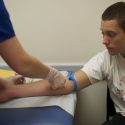e-Care of Wisconsin provides 24/7 bedside monitoring
Critically ill patients commonly develop complications and take a rapid turn for the worse with little or no advance warning. Suppose intensive care nurses and physicians could anticipate such complications before or immediately as they occur?
That is precisely what is about to happen in the Trauma and Life Support Center at University of Wisconsin Hospital as an innovative, centralized and around-the-clock monitoring system called e-Care is introduced. The system is designed to give an extra layer of support to bedside caregivers. UW Health critical care physicians and experienced ICU nurses will staff a remote “clinical operations center.” They will literally keep an eye on patients, their vital signs and trends via monitoring and alarm systems, cameras and microphones in patient rooms. The e-ICU supports early response to changes in patient condition that could develop into complications. In addition, e-Care allows the staff to interact with patients and their families. It is designed to offer “a second set of eyes” in addition to the existing level of intensivist staffing in the unit.
The technology and support with the brand name eICU was developed by VISICU, a health care information technology company.
“There is a serious and growing shortage of critical care doctors and nurses. E-Care allows us to continue high-quality care despite workforce challenges. And it will help us to recruit and retain critical care physicians and nurses,” says Ken Wood, UW Health director of critical care medicine in the TLC. “One of the many outstanding features of e-Care is an early warning system which alerts staff of potential patient complications.”
Secure data lines linking the operations center and the intensive-care unit insure that all patient data are encrypted until the information reaches either the e-Care center or the hospital. Cameras are turned off except when data show that a patient should be checked. A bell and a green light on the cameras alert those in the patient’s room that the camera is active. Anyone in the patient room will be able to contact the e-Care monitoring center by the press of a button.
E-Care also will make the routine patient care and charting more efficient by the use of virtual rounds and clinical documentation.
The system has been adopted by more than 200 hospitals nationwide as the shortage of intensive care specialists grows and as evidence builds that the earliest possible intervention may help reduce complications among the most severely ill patients.
Tags: health care, UW Health

